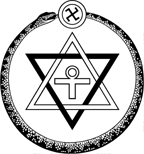 Title page for The Mahatma Letters to A.P. Sinnett (1962 edition) | |
| Author | A. Trevor Barker |
|---|---|
Publication date | 1923 |
| ISBN | 1-55700-086-7 |
| Part of a series on |
| Theosophy |
|---|
 |
The Mahatma Letters to A.P. Sinnett is a book published in 1923 by A. Trevor Barker. ( ISBN 1-55700-086-7) According to Theosophical teachings, the letters were written between 1880 and 1884 by Koot Hoomi and Morya to A. P. Sinnett. [1] The letters were previously quoted in several theosophical books (e.g. The Occult World by Sinnett), but not published in full. The letters were important to the movement due to their discussions on the theosophical cosmos and spiritual hierarchy. From 1939, the original letters were in the possession of the British Museum but later the British Library.
Contents

The book was both praised and criticized by theosophists. Dr H. N. Stokes called the book "the most authoritative work of a theosophical nature ever made accessible to the public. It is simply transcendent in its importance."